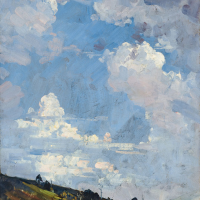33. ARTHUR STREETON

When the revered Australian Impressionist painter Arthur Streeton purchased five acres of land at Olinda in Melbournes Dandenong Ranges in 1921, few could have predicted how important it would become in the context of his life and art. The house he built there Longacres the extensive flower gardens that he and his wife Nora created, and the surrounding hills and vistas combined to inspire some of his most enduring and memorable works. Olinda became the setting for Streeton to consolidate his appreciation of momentary sensations of colour and light, a passionate interest in the relationship between painting and literature, and to explore new ways of representing the Australian landscape.
Olinda was somewhere that Streeton could easily reach from the family home in Grange Road, Toorak, purchased in June 1927. Over the next ten years, the Streetons divided their time between The Grange and the newly built Longacres house (1924). They had regular visits throughout the year, often staying for an extended period over summer.
Afternoon Sky at Olinda c1934 was painted not far from the house. It was one of the many hillside and long-range vistas Streeton enjoyed. Its relatively small size and fresh, painterly strokes indicate that it was created directly in front of the view. The chosen motif is most likely a close-up section of the left-hand side of his largest Dandenong Range subjects, A Southern View, Olinda 1933. Streeton had exhibited this painting at a retrospective exhibition held at The Athenaeum Gallery in Melbourne in August 1933 where it received favourable reviews.1
Streeton is a master of recording the intersection between land and sky and the immense variety of visual effects created by passing clouds. In Afternoon Sky at Olinda, he concentrates on a small sliver of the landscape the incline of a cleared, sunlit, open field and tree-lined hill contrasted against a vertical rectangular section of sonorous blue, greys and white puffy clouds. As one critic remarked in relation to A Southern View, Olinda, it epitomises the manner in which the warm, late sunlight is made to play over undulating tree-clad hills and valley.2
In other paintings from the mid1930s, such as The Cloud (Storm over Macedon) 1936, Streeton conveys the overwhelming drama of a lightning strike as it unleashes its enormous pent-up energy. As art historian Andrew Mackenzie writes, This strong dramatic canvas was inspired by the poem The Cloud, written in 1820 by Percy Bysshe Shelley: I wield the flail of the lashing hail, And whiten the green plains under, And then again I dissolve it in rain, And laugh as I pass in thunder.3
In Afternoon Sky at Olinda, by contrast, nature is more benign. Rather than the romantic poetry of Shelley, it finds parallels in the famous series of cloud studies of Shelleys contemporary, English painter John Constable (17761837). From 182122, Constable produced a remarkable group of en plein air oil studies of the sky and cloud formations, recording the weather conditions and time of day for each one that he painted. Paintings such as Constables Cloud Study 1821, from the Paul Mellon collection at the Yale Centre for British Art in New Haven, provide a direct antecedent to our Streeton work. In both paintings there is an uncanny understanding of the ephemeral nature and structure of a cloud formation with just a fraction of detail at the base of the painting to anchor sky to earth.4
Like Constable, it is possible to lose oneself in Streetons skies, quite literally to cloud-gazing. The subtle shifts in light and dark, engaging tonal variations, and the use of a broad range of brushstrokes ranging from short choppy brushstrokes to seductive licks of paint envelop the viewer in an amorphous mass. Only now are we beginning to fully understand and appreciate how these later paintings by Streeton celebrate Australian conditions, at the same time as they record the increasing and devastating destruction of native trees, fields and forests.
Footnotes
1. A Southern View, Olinda 1933, oil on canvas, 76 x 101.5 cm, private collection
2. The Age, Melbourne, 15 August 1933, p.9
3. Mackenzie, A., The Cloud, Artists Footsteps, accessed May 2021: https://www.artistsfootsteps.com/html/Streeton_thecloud.htm
4. Cloud Study, John-Constable, accessed May 2021: http://www.john-constable.net/cloud-study/
Rodney James, BA (Hons) MA